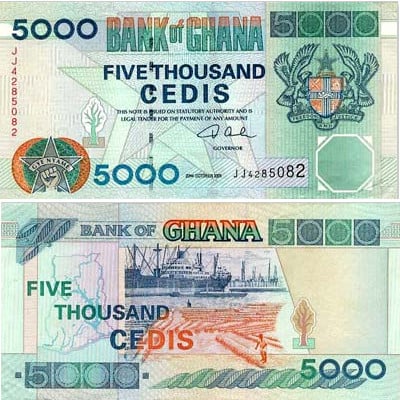
This rate was equivalent to ₵1 = 0.98 U.S. However, within months, the second cedi was devalued to a rate of ₵2.45 = £1, less than the initial value of the first cedi. The second cedi was initially pegged to sterling at a rate of ₵2 = £1. The change also provided an opportunity to remove Kwame Nkrumah's image from coins and notes. This allowed a decimal conversion with the pound, namely 2 second cedis = 1 pound. The first cedi was replaced in 1967 by a "new cedi" which was worth 1.2 first cedis. Ratio: 1 third cedi = 10,000 second cedis Ratio: 1 second cedi = 1.2 first cedis = 10 shillings Second cedi (GHC), 1967–2007 Second cedi (New cedi) Preceded by: The first cedi was pegged to sterling at a rate of 2.4 cedis = £1, or 8s 4d per cedi. The first cedi was introduced in 1965, replacing the pound at a rate of 2.4 cedi = 1 pound, or 1 pesewa = 1 penny. Reason: convenience of exchange and an opportunity to remove Kwame Nkrumah from coins and notes Ratio: 2.4 first cedi = 1 pound, or 1 pesewa = 1 penny History First cedi, 1965–1967 First cedi Preceded by: The first modern coins exclusively used at the Gold Coast were produced in 1796 but cowries were used alongside coins and gold dust as currency until 1901. The porcelain-like shells came to West Africa, beginning in the 14th century, through trade with Arab merchants. The Monetaria moneta or money cowry is not native to West African waters but is a common species in the Indian Ocean. Cowries (plural of cowry) were formerly used as currency in what is now Ghana.

The word cedi is the Akan word for cowry shell. By removing four digits, the Ghana cedi became the highest-denominated currency unit issued in Africa. The new cedi was gradually phased out in 2007 in favor of the "Ghana cedi" at an exchange rate of 1:10,000. Decades of high inflation devalued the new cedi, so that in 2007 the largest of the "new cedi" banknotes, the 20,000 note, had a value of about US$2. The "new cedi" (1967–2007) was worth 1.2 cedis, which made it equal to half of a pound sterling (or ten shillings sterling) at its introduction. one hundred old pence, so that 1 pesewa was equal to one penny.Īfter the February 1966 military coup, the new leaders wanted to remove the face of Nkrumah from the banknotes. The cedi bore the portrait of the President and was equivalent to eight shillings and four pence (8s 4d), i.e. Kwame Nkrumah introduced Cedi notes and Pesewa coins in July 1965 to replace the Ghanaian pounds, shillings and pence. The African name Cedi (1965–1967) was introduced in place of the old British pound system. In 1965, Ghana decided to leave the British colonial monetary system and adopt the widely accepted decimal system. The new republic's first independent currency was the Ghanaian pound (1958–1965). Īfter independence, Ghana separated itself from the British West African pound, which was the currency of the British colonies in the region.

One cedi is divided into one hundred pesewas (Gp). It is the fourth historical and only current legal tender in the Republic of Ghana.

The cedi ( / ˈ s iː d iː/ SEE-dee, pronounced in the same way as CD) ( currency sign: GH₵ currency code: GHS) is the unit of currency of Ghana.


 0 kommentar(er)
0 kommentar(er)
